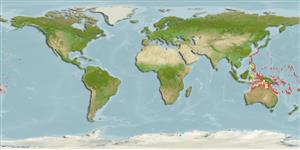Common names from other countries
Environment: milieu / climate zone / depth range / distribution range
Ecologia
marinhas associadas(os) a recifes; intervalo de profundidade 1 - 34 m (Ref. 11890), usually 1 - 12 m (Ref. 90102). Tropical; 30°N - 24°S, 120°E - 170°W (Ref. 74933)
Indo-Pacific: Moluccas and Philippines to Samoa and Tonga, north to the Ryukyu Islands, south to southern Great Barrier Reef; Mariana and Caroline Islands in Micronesia.
Tamanho / Peso / Idade
Maturity: Lm ? range ? - ? cm
Max length : 10.0 cm TL macho/indeterminado; (Ref. 9710); common length : 7.7 cm SL macho/indeterminado; (Ref. 37816)
Descrição suscinta
Chaves de identificação | Morfologia | Morfometria
Espinhos dorsais (total) : 8; Raios dorsais (total) : 9; Espinhos anais: 2; Raios anais : 8. Characterized by having dorsal fin rays VII-I, 9; anal fin rays II,8; pectoral fin rays 13; pelvic fin rays I, 5; pored lateral line scales 24; predorsal scales 3-4; circumpeduncular scales 12 (Ref. 93839); color is coppery or silvery with saddle or bar across the caudal peduncle and a wedge-shaped bar below the eye. Similar to A. fuscus but usually has fewer gill rakers (25-27 versus 28-30). Leading edge of ventral fin clearly pale-blue (Ref. 48635); characterized further by grey caudal peduncle with broad dark bar at base; pale grey at night; greatest depth of body 2.2-2.6 in SL (Ref. 90102).
Occur in outer reef slopes generally at depths below 30 m (Ref. 1602). Nocturnal species (Ref. 7300). Solitary or in small groups (Ref 90102).
Ciclo de vida ou comportamento de acasalamento
Maturities | Reprodução | Spawnings | Egg(s) | Fecundities | Larvas
Mouthbrooders (Ref. 240). Distinct pairing during courtship and spawning (Ref. 205).
Myers, R.F., 1991. Micronesian reef fishes. Second Ed. Coral Graphics, Barrigada, Guam. 298 p. (Ref. 1602)
Status na Lista Vermelha da UICN (Ref. 130435)
CITES (Ref. 128078)
Not Evaluated
Ameaça para os humanos
Harmless
Uso pelos humanos
Ferramentas
Relatórios especiais
Baixar XML
Fontes da internet
Estimates based on models
Preferred temperature (Ref.
115969): 25.9 - 29.3, mean 28.6 (based on 1393 cells).
Índice de diversidade filogenética (Ref.
82804): PD
50 = 0.5020 [Uniqueness, from 0.5 = low to 2.0 = high].
Bayesian length-weight: a=0.01445 (0.00860 - 0.02429), b=3.09 (2.95 - 3.23), in cm Total Length, based on LWR estimates for this species & (Sub)family-body (Ref.
93245).
Nível Trófico (Ref.
69278): 3.3 ±0.3 se; based on size and trophs of closest relatives
Resiliência (Ref.
120179): Elevada, tempo mínimo de duplicação da população menor que 15 meses (Preliminary K or Fecundity.).
Fishing Vulnerability (Ref.
59153): Low vulnerability (10 of 100).
